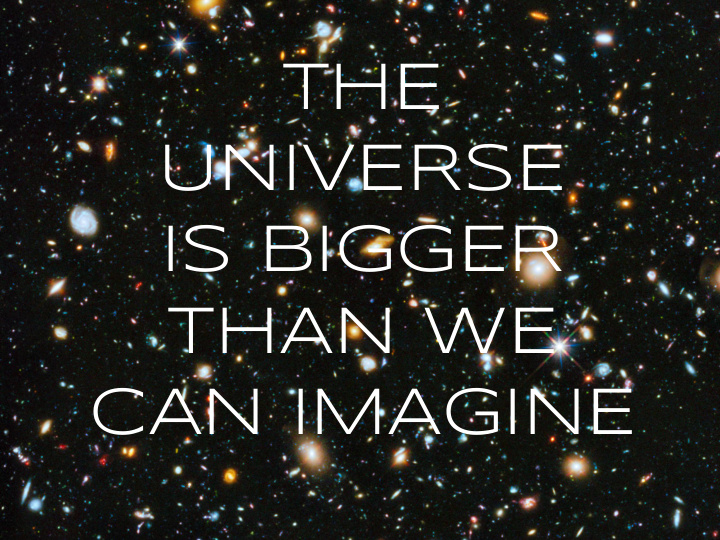



THE UNIVERSE IS BIGGER THAN WE CAN IMAGINE
About 2000 exoplanets have been discovered (confirmed) since 1988 NOT JUST DUST AND STARS...
A DIVERSITY OF WORLDS
SOME IN JUST THE RIGHT SPOT...
SOME A BIT TOO HOT, SOME A BIT TOO COLD A WIDE DIVERSITY OF PLANETS
About 2000 exoplanets have been discovered (confirmed) since 1988
20 billion Earth like planets in the Milky Way
1,000 trillion Earth-like planets in the observable universe.
So, when we do a google search for “aliens” why do we always get the same old crap?
HUMAN ACTORS IN MASKS AND MAKEUP
Trillions of planets but somehow they all look like almost exactly like us?
Maybe the students at ITP can do better?
The Challenge: Each of you has been paired up, and given a description of a hypothetical planet that is somewhat like Earth yet distinctly different in a number of ways. Your group has 8 minutes to draw a life form that you think could evolve on your hypothetical planet. Consider the environmental challenges. Discuss. Collaborate. Use your imaginations. Above all, make it plausible .
Talk about your life form with your partner before you start making the drawing. Draw on the back of the handout. Divide up the work however you want. Add a SHORT description if you want. Borrow other colors from your neighbors. START NOW!
Take some inspiration from nature...
Take some inspiration from artists...
Super Earth This planet is 2.2 times the mass of the earth. Gravity is much stronger here than on earth; moving around on it’s surface is demanding, and consumes a large amount of energy. This planet has a similar mineral composition to Earth. The planet is largely inactive volcanically and has little tectonic plate movement. Several large disconnected oceans dot the dot the surface. Large rings are visible in the daytime, and nighttime sky.
Ice Planet This planet has an eccentric orbit that takes it far away from it’s large yellow star for 3 earth years and brings it close enough to have liquid water on half of its surface for 4 Earth years. This planet is 1.2 times volume of earth. About 80% of the land is covered with water ice during the long winter. At the height of summer only 10% of the water remains frozen at the poles and on the mountain peaks. During the Summer most of the surface is swampy with heavy, moisture laden air, and tropical temperatures. During the winter this changes to frozen desolation as the sun shrinks in the sky and global temperatures plunge well below freezing.
Ocean Planet This planet is twice the size of Earth but has a surface completely covered with water. The global ocean varies greatly in depth with some areas as deep as 75 kilometers, and some areas as shallow as 15 meters. No solid land rises above the surface of the ocean, even during the lowest tides, but currents circulate dissolved minerals and other materials throughout. Temperatures remain constantly cool at around 19 degrees Celsius.
Gas Giant Satellite Planet This planet is actually a very large moon, with tall mountain ranges and deep canyons. It orbits an enormous gas giant that has a diameter 200 times that of Earth. The star is a large yellow/white star. The tides are extreme due to the gravitational pull of the gas giant, and the great differences in the height and depth of surface features. Hundreds of square kilometers of land are under or above water during any given day; rapid currents, whirlpools, and tidal waves are generated constantly.
Iron Planet This slightly smaller-than-Earth-sized planet was once the core of a gas giant. Its composition is nearly 70% iron, nickel, and other heavy metals. The gravity is nearly double that of Earth. The star is a red dwarf that emits light towards the infrared band of the electromagnetic spectrum. The surface features are subtle with very little variation in elevation. A very shallow ocean covers 45% of the surface; that is less than two meters deep on average, and supersaturated with iron and other heavy elements. The molten core produces unexpected magnetic phenomena. No moons. The dark, oxidized surface absorbs heat well and keeps temperatures moderate.
Blue Giant Star Planet This planet orbits a blue star that is four times the diameter of the sun, and throws off high energy radiation towards the UV end of the electromagnetic spectrum. Despite being far enough away from the star to have liquid water; the daytime brightness is intense. Surface temperatures at midday are high (40 - 60 degrees Celsius). UV exposure is dangerously high. The planet has a magnetosphere which keeps the nighttime sky lit up with intense auroras from the high energy particles hitting the upper atmosphere. Life forms on this planet must contend with high solar radiation and heat management.
Please fill out this form so that we can data map the results of this activity: http://tinyurl.com/otjff5e We will upload the results to the applications blog along with the rest of the material we assembled for this presentation. Thanks for participating!
Recommend
More recommend